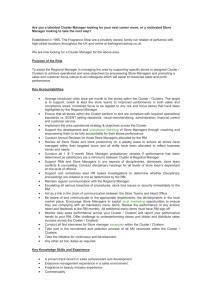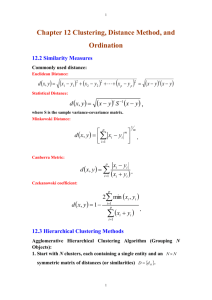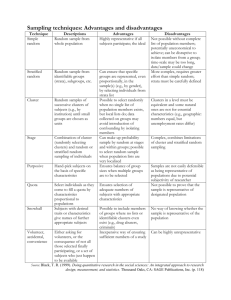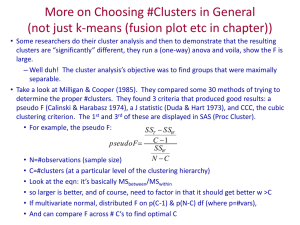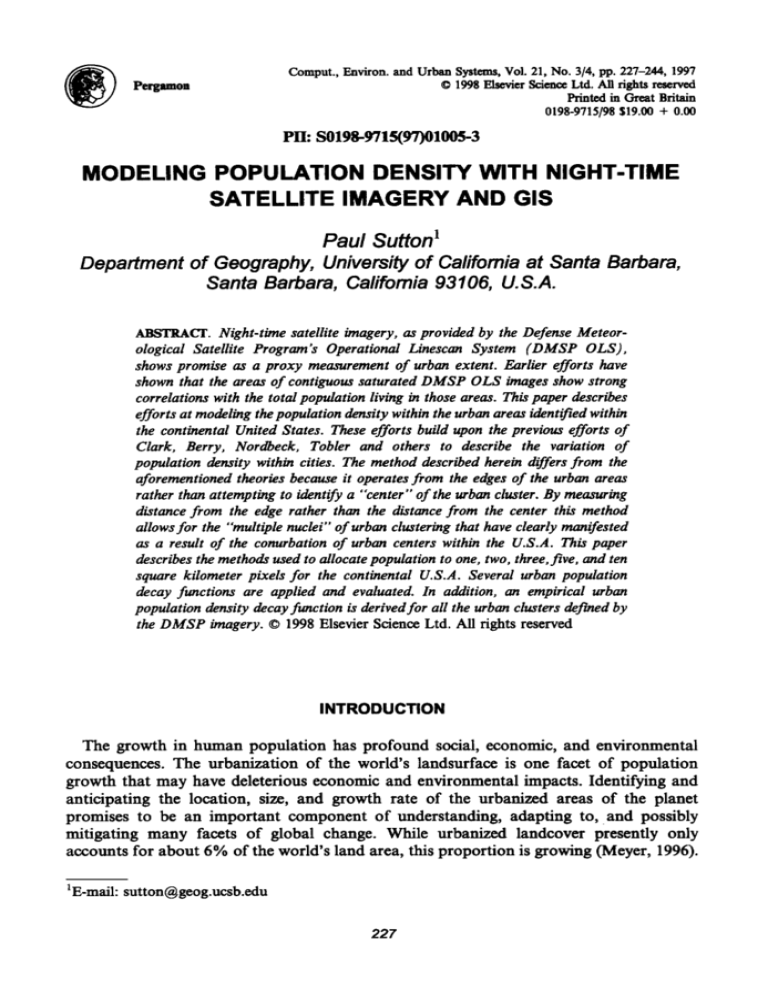
Pergamon
Comput., Environ. and Urban Systems,Vol. 21, No. 3/4, pp. 227-244, 1997
© 1998ElsevierScienceLtd. All fights reserved
Printed in Great Britain
0198-9715/98 $19.00 + 0.00
PH: S0198-9715(97)01005-3
MODELING POPULATION DENSITY WITH NIGHT-TIME
SATELLITE IMAGERY AND GIS
Paul Sutton 1
Department of Geography, University of Califomia at Santa Barbara,
Santa Barbara, Califomia 93106, U.S.A.
ABSTRACT. Night-time satellite imagery, as provided by the Defense Meteorological Satellite Program's Operational Linescan System (DMSP OLS),
shows promise as a proxy measurement of urban extent. Earlier efforts have
shown that the areas of contiguous saturated DMSP OLS images show strong
correlations with the total population living in those areas. This paper describes
efforts at modeling the population density within the urban areas identified within
the continental United States. These efforts build upon the previous efforts of
Clark, Berry, NorcPoeck, Tobler and others to describe the variation of
population density within cities. The method described herein differs from the
aforementioned theories because it operates from the edges of the urban areas
rather than attempting to identify a "center" of the urban cluster. By measuring
distance from the edge rather than the distance from the center this method
allows for the "multiple nuclei" of urbun clustering that have clearly manifested
as a result of the conurbation of urban centers within the U.S.A. This paper
describes the methods used to allocate population to one, two, three, five, and ten
square kilometer pixeis for the continental U.S.A. Several urban population
decay functions are applied and evaluated. In addition, an empirical urban
population density decay function is derived for all the urban clusters defined by
the DMSP imagery. © 1998 Elsevier Science Ltd. All rights reserved
INTRODUCTION
The growth in human population has profound social, economic, and environmental
consequences. The urbanization of the world's landsurface is one facet of population
growth that may have deleterious economic and environmental impacts. Identifying and
anticipating the location, size, and growth rate of the urbanized areas of the planet
promises to be an important component of understanding, adapting t o , and possibly
mitigating many facets of global change. While urbanized landcover presently only
accounts for about 6% of the world's land area, this proportion is growing (Meyer, 1996).
1E-mail: sutton@geog.ucsb.edu
227
228
P. Sutton
Furthermore, in terms of human population, urban areas are growing both in total and
percentage terms and now account for over 50% of the human beings on the planet.
Increased global urbanization may significantly alter local to regional climates while
contributing directly to increased emissions of greenhouse gassvs, land degradation, and
the loss of productive cropland (Berry, 1990). Accurate data on the spatial distribution of
human population is critical in addressing the causes and impacts of global environmental
change. High quality data on the size and distribution of the human population over the
whole planet is critical in order to monitor, understand, respond to, and perhaps even
prevent environmental degradation, loss of biodiversity, and resource depletion in many
parts of the world. Fine resolution population density data has been used to measure
changes in land-use patterns within the United States (Hitt, 1994). An increased
understanding of how the density and distribution of human population varies within
and between urban areas could contribute to the development of improved ability to
monitor and predict the distribution of the human population.
This work utilizes the U.S.A. as a regional study in order to inform further studies in
other parts of the world. Identifying relationships between the total population of
urbanized areas and the size of urbanized areas using information such as gross domestic
product (GDP) per capita, most common means of transportation, distribution of wealth
characteristics, and energy consumption per capita could prove useful in predicting future
rates of urbanization. This work may be effectively incorporated into dynamic historical
models of human transformation processes such as urbanization described by Acevedo,
Foresman, and Buchanan (1996).
Two aspects of urbanization arc very important with respect to land-use and land-cover
change. First, most urbanization is unidirectional, culminating in the virtually permanent
conversion of productive agricultural land into settlements (Meyer, 1996). Urbanization as
a threat to agricultural lands has been demonstrated using DMSP imagery in the U.S.A.
(Imhoff & Lawrence, 1997). Second, most of the urban population of the planet live in
under-developed nations that are striving for increased economic development and
technological progress. Historically, the cities of the developed countries have gone
through a process of counter-urbanization in which the size of urban areas has spread
dramatically (Keyfitz, 1990). China is notable as a country in which the parallel
demographic, economic, and environmental developments it is undergoing are likely to
have substantial global repercussions. China represents about one-fifth of the world's
population and its economy has been growing at staggering rates for over ten years.
China's cities have higher population densities than the U.S.A.; however, if their growing
wealth changes the nature of urbanization in China we may be seeing unprecedented rates
of urbanization that consume agricultural lands that are vital to world food supplies
(Brown, 1995). If the cities of the developing world continue to follow historical patterns of
urban growth, we are certain to see unprecedented changes in land usefland cover that will
undoubtedly have profound impacts on cropland and the environment.
This paper describes a means of modeling human population density within urban
clusters as defined by the Defense Meteorological Satellite Program's Operational
Linescan System (DMSP OLS) night-time satellite imagery. The ground truth for
measuring the accuracy of these models was a 1 km 2 resolution grid of the population
density derived from the 1990 U.S. decennial census. The urban density models used were
parameterized with only two pieces of information: (a) the size and shape of the urban
clusters defined by the DMSP OLS imagery and (b) a log-log relationship between the size
Modeling Population Density
229
of an urban cluster and its total population that is described in a another paper (Sutton,
Roberts, Elvidge, & Meij, 1997).
METHODS
The datasets used to perform these analyses were continental coverages of the U.S.A. at
a resolution of one square kilometer. The DMSP OLS data is a stable city lights image
produced by Elvidge, Baugh, Kihn, and Davis (1995). This image used 232 orbits of the
DMSP OLS data archives. The use of multiple orbits was needed in order to obtain a
composite image of stable light sources. Clouds, lightning, and the phase of the moon
among other things can cause significant variation in DMSP OLS imagery from one orbit
to the next. The second dataset was an image or "grid" of the continental U.S. population
density derived from 1990 census data at the block group administrative boundary level
(see Figure 1). The grid was derived from the block group layer of the Bureau of the
Census' Topologically Integrated G-eo-referenced and Encoded Referencing System
(TIGER), and proportionally allocated to 1 km 2 cells. This dataset was developed by
the Socioeconomic Data and Applications Center (SEDAC) at CIESIN (Meij, 1995). It
should be noted that this dataset was used only as a reference for the models developed
from the DMSP OLS dataset. Previous analyses showed that the saturated D M S P pixels
capture over 80% of the population on only 10% of the land; however, these efforts did
not reallocate population density back to the one square kilometer pixel (Sutton et al.,
1997). The earlier effort verified the DMSP OLS data as a feasible method for determining
the areal extent of urban areas. It showed that these urban areas showed a strong
relationship with their corresponding total populations. This relationship is very similar to
the works of Clark, Stewart, and Welch (Clark, 1951; Stewart & Warntz, 1958; Welch,
1980). The methods described here explain various means of disaggregating the total city
population back to the one square kilometer pixel that make up the city cluster.
The methods adopted involve taking advantage of the spatial nature of the DMSP data.
The DMSP image used was simply a binary image with saturated values and dark values
(see insets of Figure 2). The saturated pixels of the DMSP OLS image were grouped into
urban clusters based on their adjacency to other saturated pixels (Figure 2). Each saturated
pixel in the DMSP OLS image was classed based on both a number uniquely identifying
the cluster to which it belonged and a number representing the distance of that pixel to the
edge of the cluster to which it belonged. This resulted in over 5,000 distinct clusters. The
distance is defined as the shortest distance from the pixel in question to a non-saturated or
dark pixel. One additional manipulation was incorporated to account for coastal and
border cities. This was done to account for the fact that the densest parts of cities such as
Chicago, Los Angeles, etc. are often right on the coast. Consequently the pixels of the
ocean, lakes, and Mexican and Canadian borders were treated as if they were saturated
pixels. This resulted in coastal and border cities having the highest distances to the edge on
the center of their coastal or border contacts (Figure 3 shows the distribution of distance
values, and data structure for three fictitious clusters of different shape but equal area,
including a coastline cluster).
The following is a description of how the grid with cluster identification information is
combined with the distance to the edge of cluster grid. The data structure of Grids in Arc/
INFO includes a table called the value attribute table (VAT) which contains two items: a
230
P. Sutton
V&IUeSnigher mall
1.00.
0.900.80-
r
the cumulative percentage ofpopulatien chart on
the lower left for an enhanced understanding of
the distribution of these cell values.
300,000
0.70-
200,000
This graph represents the
[
proportic~t of the Contine*ttal [
United States that lives at or i
below the corresponding I
population density plotted
below.
0.60-
0.~0.40~
0.300.20"
0.10 i
0.00"
Z> hOWeVermey all nave lOW
frequencies that do not show up at this scale. See
....
M
~.,
100,000
' "° " ' ' ° , . . . o.
12345678910
~
i~1
12 14 16 18 20 22 24
~,000
Population Density (persons / sq kin)
i ....
, ....
i ....
i ....
i'
10000 20000 30000 40000 50000
Population Density
F I G U R E 1. Grid of population density of the Continental United States derived from 1990 U.S. c e m m
block groups.
VALUE and a COUNT. The value represents the value assigned to the pixel or cell. The
count is the number of pixels that have that particular value. In order to produce a grid
that incorporated both the distance to edge information and cluster identification, the
following manipulation was performed.
First, the grid which had unique values for each of the clusters (which had a VAT whose
COUNT represented the area of each urban cluster in square kilometers) was multiplied by
a thousand. This would result in cluster number 1 becoming cluster number 1,000. The
Modeling Population Density
231
16"
14"
~
12"
10"
6"
4"
2 o
0 o
01234
5678910
12
LB(ClnsIer Area)
~4
15
Nominally classified Urban clusters with insets of
the Los Angeles and Baltimore-Washington corridor shown
in the binary state of the DMSP image. Figures 7 & 8
show the models applied to these binary insets. The
points in the regression on the upper right are defined by clusters in the image in the upper left.
The regression is weighted by the total population of the clusters. Without weighting, a small
town in Nevada would count as much as the New York City cluster. The regression parameters are:
Ln(Cluster population) = 3.353 + 1.3$9*Ln(Cluster Area).
It is worth noting that the L.A. cluster had the largest absolute error of all the clusters in this study.
FIGURE 2. DMSP O 1 ~ nlght-time satellite image showing saturated pixels in nominal colors
iden/ffying adjacent pixels which form urban clusters.
distance to edge grid was multiplied by ten and truncated to integers. This resulted in each
pixel having values that represented their distance to dark continental U.S. land in tenths
of kilometers. At this point, however, a pixel on the edge of the New York cluster is the
same as a pixel on the edge of any other urban cluster including the Los Angeles, Phoenix,
and Tucumcari dusters. The values of all these pixels are less than 100 kin; consequently,
adding the cluster ID grid to the distance to edge grid results in a grid in which each pixel
has a value in which the numbers from 0 to 999 represent the pixel's distance to the edge of
its cluster, and the numbers from one thousand and up represent a number that uniquely
identifies the cluster in which that pixel occurs (e.g., the pixels on the edge of duster
number 1 have values of 1010 (10 being the smallest distance value)). The VAT table that
232
P. Sutton
Maps of Sample Urban Clusters[
(Values in cells represent distsnces to edge)
~L
[
Distribution
of Distance
Values
16 @ 1.0 km
4 @ 1.4 km
4 @ 2.0 km
4 @ 2.2 km
1
'°'
@ 3.2 km
29 - Total Area
Value Attribute Table of
[
Sam of C~tK I~!000 md Dig 2 Edlle
I
VJ~Ug
COUMT
11010
11014
11020
16
4
4
11022
11032
4
1
Cluster #11
(FairlyRoundinShspe)
VALOE
19 @ 1.0 km
6 @ 1.4 km
2 @ 2.0 km
2 @ 2.2 Pan
10 2( 10
1~I,2~2:.
1o1oL,
l,
I
309010
309014
309020
19
6
2
309022
2
Cluster #309
O r m ~ y Shaped)
[~1o
VALUE
11 @ 1,0 km
4 @ 1.4 km
4 @ 2.0 km
3 @ 2.2 km
2 @ 2.8 kJn
1 @ 3.0 km
2 @ 3.2 km
1 @ 3.6 km
1 @ 4.0 km
Land
22 12 lo lo L
28122 20 14 ;10
2 Le2°'z~
30 20 10
Ocean
[
29 = Total Area
~o 1, 10110
COUNT
29 ffi Total Area
Clnstco-eery
]-~1
J
COUNT
711 010
11
711 014
4
711 020
4
711 022
3
711 028
2
711 030
1
711 032
2
711 036
1
711 040
1
FIGURE 3. Three sample urban elugers of equal area with VAT structure.
Grid produces conveniently supplies the number of unique occurrences of each value.
Thus, the VAT table for this grid has values which contain both the distance to edge
information and count information that indicates the number of pixels that are a distance
"x" from the edge of "Cluster Y" (Figure 3).
Modeling Population Density
233
The question then becomes: How does one apply the traditional models based on a
circular city to the irregularly shaped clusters identified from the DMSP night-time satellite
imagery? The next stage of this analysis involves the manipulation of the VAT for the grid
just described. The manipulation involves adding new columns to the table which are used
to model the population density within each cluster according to any integrable function
describing the decay of population density from an urban center. However, this model
turns the distance function around and uses distance from the edge of an urban center
instead. None the less, the decay functions used will be the traditional functions proposed
describing population density as a function of distance from the urban center.
The way this was done was via manipulation of the VALUE and COUNT items of the
VAT for this grid. A simple program was written that calculated the following: (a) cluster
ID, (b) cluster area, (c) radius of equivalent circle, (d) total population of cluster, (e) upper
limit of integration for equivalent circle at distance "D", (f) lower limit of integration for
equivalent circle at distance "D", and (g) population density estimate. Most of these values
can be found for the clusters shown in Figure 3 in the table at the bottom of Figure 5. This
table has population density estimates for all of the urban decay functions described in
Figure 4. Cluster ID was obtained simply by dividing by 1,000 and truncating. Cluster area
was obtained by summing the count values by cluster ID. The radius of equivalent circle
was obtained by simply solving the equation: cluster area=~ x(R) 2 for R. Total
population of cluster was obtained by using the formula obtained from previous work
describing the linear relationship between the natural log of the population of urban areas
and the natural log of the area of those clusters: total population of cluster=
exp[3.359 + 1.359(cluster area)] Sutton et al., 1997). The R-square for the weighted linear
regression of this log-log relationship is 0.97. The limits of integration warrant further
explanation. It is important to know that the VAT file is sorted in ascending order. The
limits of integration are calculated in the following manner. The urban population density
functions all begin at a distance of 0 and end at a distance of 1, with the highest or central
population densities at 0 (Figure 4 describes the urban decay functions used). The limits of
integration are merely the radii of circles nested inside a circle of radius 1. An example is
provided both here and in more graphic detail in Figures 4 and 5. Suppose a cluster has
100 one square kilometer pixels in it, 35 of these pixels are on the outer edge of this cluster
with a distance value of 1 km from the edge. The upper limit of integration for these pixels
would be 1.0 and the lower limit of integration for these pixels would be the radius of a
circle that contained 65% of the area of the unit circle (65% comes from 100 total - the 35
in question). The unit circle has an area of ~, thus by solving the equation:
0.65xTr=~x(R) 2 for R, the lower limit of integration is obtained, e.g., 0.806. These
radii are solved cumulatively within each cluster ID resulting in steadily decreasing limits
of integration as distance from the edge increases to its maximum and the last lower limit
of integration is 0.
These limits of integration are then used in the definite integral associated with various
urban population density decay functions shown in Figure 4. The value of this definite
integral is the proportion of the total population that live in the pixels which are that
distance from the edge of the cluster. This fraction is multiplied by the estimated total
population of the cluster and divided by the number of pixels at that distance to produce
an estimate of the population density of those pixels. It may be important to note here that
all the pixels at a distance "x" from the edge of a particular cluster will be assigned the
234
P. Sutton
Name of Population
Density Decay
Function
2-1) curve of
function on
the 0 to I interval
Definite Integral
of Function on
left rotated about
Z-axis as on right
Algebraic
Expression
of2-D curve
3-D representation
of function rotated
about Z-axis
Uniform
x2
2
I,~ ¸
Y=I
1
x^2
0~2
0.4
0.'6
0.8
I
I×1
0.~
i
Linear/Conic
!
x2
0.8 ~ \
0.6
Y=l-x
"~
0.2
0.4 0.6
0.8
3(~2/2y(xA313))
xl
I
Parabolic
1\
a8 \
Y=(1-x)
0.4
~2
a2
~4
a6
a8
x2
2
xl
i
Exponential
)<2
-X
0.8
0.7
0.6
0.5
0.4
Y=e
,-..
~'~,.
0.2 0,4 0.6 0,8
-e(eA(-.X)*(x+I))
.7128
xl
I
Gaussian
1
O,6
0,4
0.2
y_##
x2
~(3(xA2))
xl
as 1 1.8 2 Z8 i
FIGURE 4. Graphic and algebraic representatiom of urban population demity decay functions.
same population density value. The integrals solved are the urban population density
decay functions rotated about the y axis. For a graphic description of this method of
estimating population density see Figure 5.
Several different functions were used to model the population density within each urban
cluster (Figure 4). The simplest was a uniform model which simply assigned each pixel the
same average population density on a per cluster basis. The second was a simple linear
235
Modeling Population Density
Clusters
Equivalent
(darknessof shading
propoaional ~ Pop Den)
Radii Calculations for
Cluster #11
R1 = 3.038 *.1857=0.564
R2 = 3.038 *.4152=1.261
R3 = 3.038 *.5571=1.692
R4 = 3.038 *.6695=2.034
R5 = 3.038 * 1.000=3.038
I ~r~,t,
Cluster#11
ro,.,~i~,~o~ ) I
Population Densities (pers/km sq)
Allocated to regions of Cluster #309
Using Exponential PDF
A r e a "A": D = l . 0 k m @ 81.1
A r e a "B": D = l . 4 k m @ 111.5
A r e a "C": D = 2 . 0 k m @ 131.9
l
Circles
Clusl.er#309~.~*,~:,~¢[
A r e a "D": D = 2 . 2 k m @ 152.8
g
i
~..e-
Total Population Calculation
Total Population = 2,777
Exp[3.353 + 1.359*In(Area)]
where Area = 29 km sq
[Note: This value is the same for
all the clusters described here]
~ClmWlnm
tNsaMmm
11
' 'i'.~
m
s~s
,to
1~s
11
1.40
4
05571
a~6
~.8
110.4
85.8
g7.9
29.8
11
zoo
4
84152
a~vl
~8
1~s
l~ar
11(18
184.1
11
11
309
31~
309
309
711
711
711
711
711
711
711
711
711
Zm
2.80
4
1
(11857
(10000
0.4152
(118ff/
96.8
g~8
2"/2.0
4433
272.6
4432
137.4
180.8
381.6
739,9
1.00
19
6
2
2
11
4
4
3
2
I
2
1
1
0,5872
1.0000
(15B72
0.3714
(1~
1.0000
(17878
0.~48
(1~872
0AQ13
(141~2
(13714
G21~8
(11857
mS
g5.8
858
95,8
958
g5.8
~8
858
95.8
958
958
g5.8
95.8
53.9
14L6
Ig5,7
237.6
29.3
73.8
102,6
131.9
157.0
1742
1957
222A
2522
28.3
....'1~,3,
2~.9
384.0
81.1
111.5
131.9
15P_S
6.3
117.5
344,8
841.5
7.8
73.8
as
382
73`8
121.9
171,8
211.4
288,9
344.8
441k4
73.8
88.3
96.2
106,7
122.4
131+9
t44.4
160,6
6.3
22.0
63.3
135.5
213.5
344~
542.6
739,9
IA0
2.00
2.20
1.00
1.40
200
220
2.60
3,00
3.80
4,00
4.10
d
~
zll.l~l~
___
03714
(12628
(10000
(17878
(16948
(15872
(14913
0,4152
(13714
0.2828
0,185"/
(10000
~
~
I I~mldc
~
78o
~5
The three urban clusters with their proportional equivalent circle and a table denoting the various estimates
of population density within them based on the five population density decay functions described in Fig 4.
Each cluster has an area of 29 km2which is modeled to a circle with a radius of 3.038 kin. The estimated
population for each of the clusters is 2,777 persons. The various population density estimates are presented
in the table.
FIGURE 5. The three urban dusters of Pigure 3 with an equivalent circle and table with population
den,Sty esmnmtes.
236
P. Sutton
function that decreased from 1 to 0 over the range 0 to 1. The third was a parabolic
function that decreased from 1 to 0 over the same 0 to 1 range. The fourth was an
exponential decay which ranges from 1 to e x p ( - 1) as distance varies from 0 to 1. The fifth
was the standard Gaussian distribution for which the limits of integration were bumped up
to 3 to include the first three standard deviations. An appropriate multiplicative constant
was used on each of the definite integrals to insure that they all integrated to unity over the
limits of integration: 0 to 2 ~ and 0 to 1.
In addition to applying these theoretical models to estimate the population density
inside these urban clusters, it was also possible to determine empirical population density
decay functions from the actual population density data. The grid or image that contained
the distance to edge information in aH the saturated pixels was overlaid over the actual
population density grid. An average population density was calculated for each distance
value. In addition a standard deviation was determined for each distance value. Plots of
distance to edge of cluster vs. average population density and standard deviation of
population density can be found in Figure 6. The sample size for these plots decreases with
increasing distance. The left-most point for both of these plots is based on calculating the
average population density and standard deviation of the population density for all of the
pixels that are on the edge of any cluster. As the distance to the edge of the cluster increases
the sample size (e.g., number of pixels used to calculate these values) drops significantly.
As one moves to the right in these plots, to greater distances, one is moving into the hearts
of these urban clusters. The first plot shows that population density does indeed increase
with distance to the edge of the urban cluster. In fact, close inspection of the point pattern
suggests a Gaussian-like curve for distances from 0 to about 15 kin. None the less, a simple
Average Pop Density vs. Distance to Edge of Cluster
~j
Std. Dev. ofAvg.Pop Den vs. Distanceto Edgeof Clmter
I
35oo -I
g
,4
Jl
3000 "I
i3ooo
g.,
!!,ooo
R : 0.87
.
~
. .5.~.
•
~
-~ R : 0.79
". ".% "~,.'.
'~,".~:2-.~
•,%~;, .:
/,,4,..,.,.,.,.,.,
o
0
nJmmcefrome ~ of clmm' 11/10Kn)
Population
f
Dbtance to
D~n,ity = 25.5 + 75.0 ~Ed~e oga,,~
50 100 150 200 250 300 350
Dbhmcefromedgeof duster (1/10Kin)
Standard Deviation of m l ~ A A . . . .
I Distance to
Population Density ~ i ~ . t . - w "~" O.~F/~ Edge of Cluste
The empirical measurements of the Aver•ge Population Density of the pixeis of the urban
clusters •s • function of distance to the edge of the duster. The plot on the right shows the standard
deviation of these average population densities as • function of distance. The standard deviation is
• Imost directly proportionul to the mean as • function of distance. This is true when all the clusters
are considered at once and when they are classified by total area as inHg 9.
F I G U R E 6. Two graphs showing/he average population deusity of cluster pixels and standard deviation
of popular/on dewdty as a function of distance from edge of cluster.
Modeling Population Density
237
linear fit on this curve produces an R-square of 0.87. This linear fit was used as an
empirical model for the population density. It will be compared to the theoretical models
in the Results section. Clearly the plot looks as if there are some problems with heteroscedasticity. Some of the appearance is undoubtedly due to the declining sample size as
distance increases; however, it is still likely that there is heteroscedasticity.
The second plot is the standard deviation of the population density for the pixels with
increasing distance to the edge of these clusters. It is interesting to note that the standard
deviation increases with distance from the edge and is directly proportional to the mean for
which it is measured. This does not bode well for the models described here. It indicates
that any models that have uniform estimates of population density for all pixels at a given
distance from the edge of a cluster will be unable to capture inherent variability in the
population density for constant distances to the edge of urban clusters. In other words, all
the pixels on the edge of an urban cluster have a standard deviation of population density
that is almost as large as their average population density. It should also be noted that
values for distances greater than 35 km were available but were not included in these plots.
They were based on extremely small sample sizes because they were pixels deep in the heart
of only the largest urban clusters. One possible means of reducing the increasing variance
of the average population density would be to first classify these urban clusters based on
either their absolute area or total population and then produce these kinds of curves for
clusters of approximately the same size.
RESULTS
The theoretical models for estimating population density were applied to every urban
cluster of the continental U.S.A. with each of the urban decay functions described in
Figure 4 at spatial resolutions of 1, 2, 3, 5, and 10, square kilometer pixels. Table 1 is a list
of all the cross-correlations between the model and the actual population density. The
correlations were obtained by comparing and cross-correlating only those pixels in the
urban clusters. (The figures would be a little higher if the dark or "source" areas were used
with low or zero estimates of population density.) It is worth noting that the actual urban
population is about 194 million whereas the model predicts 214 million. This total bias of
20 million across the nation is a result of using the regression parameters from the log
transformation of the population and area of the clusters. There are 591,351 saturated
pixels in the DMSP OLS city lights image which have an average corresponding
population density of 321 persons/kin 2. All of the models have an overall average
population density estimate of about 362 persons/kin 2. This kind of bias could easily be
Table 1. Correlation {R} Between Model and Actual Population Density as a
Function of Spatial Resolution and Population Density Decay
Uniform
Linear/Conic
Parabolic
Exponential
Gaussian
1 km 2
2 km 2
3 km 2
5 km 2
10 km 2
0.293
0.518
0.546
0.428
0.541
0.319
0.562
0.59
0.464
0.584
0.339
0.594
0.62
0.489
0.614
0.364
0.629
0.652
0.516
0.647
0.414
0.691
0.714
0.566
0.709
238
P. Sutton
corrected for by using nationally aggregated population figures and reducing all estimates
by such a proportion.
Another issue is the question of how well these two datasets are registered spatially. The
tables below represent the cross-correlations between the model and the population density
dataset for the Gaussian model at the five different spatial resolutions. The middle value is
the correlation obtained at what is believed to be the true registration. The values in the
surrounding cells are the correlations obtained when the image derived from the model has
been shifted by the corresponding number of cells. In essence these figures show the
influence of registration error on correlation at a range of scales. These tables suggest that
the registration for these datasets is probably pretty good because the correlation is highest
at the preferred registration at all scales.
0.55
0.58
0.41
0.55
0.57
0.48
0.54
0.56
0.50
0.60
0.71
0.47
0.58
0.65
0.52
0.57
0.61
0.53
0.53
0.56
0.43
0.55
0.56
0.48
0.53
0.55
0.50
10 km x 10 km Pixds
5 km x 5 km Pixels
3 km x 3 km Pixels
0.47 0.'49 0.50 0.47 0.42
0.47 0.49 0.49 0.48
0.45
0.49 0.53 0.55 0.51 0.44
0.48 0.51 0.52 0.50
0.47
0.50 0.55 0.58 0.52 0.46
0.49 0.52 0.54 0.51
0.47
0.49 0.52 0.54 0.50 0.45
0.48 0.50 0.51 0.49
0.46
0.46 0.48 0.48 0.46 0.42
0.47 0.48 0.48 0.47
0.45
2 km x 2 km Pixels
I lun x I k m Pixels
Figures 7 and 8 are representations of the parabolic model applied to the Los Angeles
cluster and the Baltimore-Washington DC cluster respectively. The uniform gray area is
not saturated in the DMSP OLS image and is consequently not modeled at all.
Superimposed on the gray-scaled model is a contour map of the actual population density
of these areas. The contour map is a gross generalization of the actual 1 km 2 population
density grid of these areas, but it does give an overall feel of the actual population density
of these areas. The grid of population density has a much higher degree of variability than
is suggested by the contour lines. None the less, these images suggest a correlation between
the model and the population. Surprisingly the correlations for these clusters have R 2
values of only 0.22 and 0.25 respectively (Figures 7 and 8). Yet these figures are none the
less representative of the model's general application because the R 2 values are typical of
the model for the whole continental U.S.A. These R z values are low because of the model's
inability to identify variability of population density at constant distance to edge. The
standard deviation vs. distance curve of Figure 6 clearly shows one of the reasons that
these R 2 values are as low as they are. In fact, it is surprising that the models capture as
much of the variation in population density as they do considering the fact that they are
derived from a binary image.
An empirical model derived from the linear regression shown in Figure 6 was also
developed. In this model the estimated population density was simply the parameters of
Modeling Population Density
239
The parabolic population density decay function applied to the Los Angeles cluster and
environs. The contour lines are the actual population density and are at intervals of S00
persons/km2. The correlation (R) between the actual population density and the modeled
values for just those pixels in the L.A. Cluster is: 0.51. The smaller inset is an image of
the actual population density minus the predicted population density. A distribution of these
! values is to the right of this inset.
HGURE 7. A representationof/he parabolicmodelappliedto the Los Angelesduster with a population
demudtycoutou~map superimposedover/he model.
the linear regression: estimated pop. den. = 25 + 75 x (distance to edge in kilometers). This
model overestimated the total population of the urban clusters of the U.S.A. by a b o u t
11%. The mean value of the empirical model was 358 whereas the actual average
population density of the cluster pixels was 321. The empirical model did have the best
correlation with the actual population density but not by a large margin. The correlation
{R) between the empirical model and actual population density on the one square
240
P. Sutton
FIGURE 8. A representationof the p~rabolicmodel appliedto the Boston--W=dtln~onDC corridor
cluster with a populationdensitycontourmap superfumpoeedover the model.
kilometer scale was 0.578. Recall that the one kilometer parabolic and Gaussian models
had correlations of 0.546 and 0.541, respectively.
One means o f improving the empirical model would be to classify the cities into subgroups based on either their areal extent or total population and then determine the
empirical population density decay function. This would eliminate the averaging o f pixels
on the edge o f large clusters such as New York from pixels on the edge o f small clusters
like Santa Barbara. Figure 9 shows the plots of average population density as a function o f
241
Modeling PopulationDensity
distance for six different size classes of urban cluster. As cluster size diminishes the greatest
depth also diminishes. Plots of standard deviation of population density are not shown but
all of them show the same pattern as described in Figure 6. It is interesting to note that the
slope parameter for the two large classes of urban cluster is lower than the slope of the four
The Urban Clusters
classified by size. Plots below
show empirical measurements
of population demity as a
function of distance to edge of
cluster for each size class.
Linear Regression data
is provided for each size
category. Each point in the plots
is the average of all the pixels
at that distance from edge of a
cluster in the cities of that size.
As depth into duster increases
the number of pixels used to
calculate the averege pop.
density diminishes. About 2%
of the data come from pixels
that are very deep (at large
distances) in the cluster. These
were not included in the plots
if they were derived from
samples of less than 30 pixels.
•, "~'.~ !
11 clusters with
Area > 5000 km~
.........
R == 0,94
Slope:
80 (persons/km2)/km
Average Population Density (Y) vs. Distance to
Edge o f Cluster (x) for the Megacities
t~
.......
/
J
t
/
/
:7,/ '
.........
i
i
1'50i
R 2 = 0.98
Slope:
108 (persons/km~)/km
fitv (Y~Ivs. Distance to
Edge of Cluster (x) for the Medium Cities
R'S~0"93
73 (persons/km~)/km
Average Population Density (Y) vs. Distance to
Edge o f Cluster (x) for the Very Large Cities
Average Population Density (Y) vs. Distance to
Edge o f Cluster (x) for the Small Cities
/
i
R == 0.92
Slope:
ii
! 118 (persons/km2)/km
J
Average Population E
Edge o f Cluster (x
)ensity (Y) vs. Distance to
x) for the Tiny Cities
F I G U R E 9. Plots o f the empirical population density decay functions for six different sizes
o f urban duster.
242
P. Sutton
smaller classes. The population density gradient for the large cities is about 75 persons/kin 2
per kilometer. It is about 110 for the four smaller classes. This suggests that, on average,
the population density increases more rapidly with depth for small urban clusters than it
does for large urban clusters. This may be due to the fact that the large urban clusters are
primarily composed of the conurbations of one or more separate cities. The San Francisco
cluster includes Oakland, San Jose, and other cities. The New York cluster reaches into
Connecticut and New Jersey. Conurbation may result in deflating the gradients as
measured in this way. None the less, the empirical curves are interesting and linear
regressions are an oversimplification of the gradients. All of the curves show population
density increasing with distance in ways reminiscent of the theoretical exponential decays
of traditional urban geographic theory.
A model was built in which each cluster was classified by size and then modeled based
on the corresponding regression shown in Figure 9. This model showed no significant
improvement on the single empirical model of Figure 6. This shows that in order to
improve correlations it is necessary for future models to include information that accounts
for the variability in population density that occurs at constant distances to the edge of
these clusters.
DISCUSSION
The method of modeling population density presented here requires very little input
information. The only information used is a binary DMSP image and a relationship
between area and population for urban clusters. The model is then developed using the
spatial information in the image and applying various urban population density decay
functions to the urban clusters. These theoretical models explain almost as much variation
as empirically derived population density decay functions that depend on distance alone.
These rather simple beginnings may prove to be a good starting point for the development
of a more accurate method of modeling population density that uses additional
independent sources of information such as those produced by the USGS at the EROS
data center which include the NDVI greenness index from AVHRR, digital elevation data,
climate, and more (Loveland, Merchant, Ohlen, & Brown, 1991). In addition, a low-gain
version of the DMSP imagery will soon be available. It may prove to be quite useful
because it shows much more variation within the urban clusters (e.g., the images are not
saturated).
The concept of population density is an abstract one. Consequently, attempting to
model it raises many questions. The ground truth data used in this paper was derived from
a vector dataset of the blockgroup polygons of the 1990 U.S. census. Assumptions were
made to convert this dataset to a grid. One assumption is the uniformity of population
density within the block group polygons. Using this dataset as the ground truth may not be
entirely appropriate. Alternative ground truthing methods may show that the correlations
obtained here are actually underestimates. The census is also a measure of the night-time
population location. Despite the fact that the DMSP imagery is also produced at night, it
may be providing clues as to where the population is in the day also. The downtown areas
of many cities show up as very bright despite the fact that they often have lower uight-time
population densities. These population densities are much higher during the working hours
of the day. How much does the population density of an urban center vary on a temporal
basis? Clearly it is difficult to measure the error inherent in a model of this nature because
Modeling Population Density
243
the truth is an elusive quantity that varies temporally and spatially in complex ways that
are difficult if not impossible to measure for appreciably sized areas. Future work will
focus on identifying additional information that can augment that captured by this model.
In addition, these models will be run on other countries of the world to determine whether
aggregate national figures such as GDP, GDP per capita, percent of population in rural
areas, and other such figures can explain any of the expected variability between nations in
the relationships between population and night-time satellite imagery. Earlier work has
shown that the relationship between settlement size and settlement population varies
dramatically at some regional and international scales (Stewart & Warutz, 1958;
Nordbeck, 1965; Tobler, 1969). Explaining this variation with aggregate national
economic, demographic, and political data could greatly improve our ability to predict
rates of urbanization in parts of the world where good population data does not exist.
CONCLUSION
The model described in this paper accounts for 25% of the variation in the population
density of the urban areas in the continental U.S.A. from information contained in a
binary image derived from DMSP OLS imagery and some relatively simple spatial
analysis. This may prove to be a good foundation for developing a model of population
density estimation for other parts of the world where census data is not available. Future
efforts will focus on improving the correlation between the model and reality via the
inclusion of additional information from the AVHRR and DMSP OLS low gain satellites.
It is hoped that this information will account for variability in population density that
occurs at constant depth within the urban clusters defined here. Any overall bias in these
models can easily be corrected with aggregate national and/or sub-national population
totals. Additional ground truth data will be obtained in countries with varying levels of
economic development, rural/urban population ratios, and predominant means of
transportation in an attempt to explain large scale variation in population patterns that
is expected across these variables.
ACKNOWLEDGEMENTS This research was supported in part by a SUCSB California
Space Grant Fellowship, a NASA Earth System Science Global Change Fellowship, The
National Center for Geographic Information and Analysis, and The UCSB Geography
Department. This assistance is gratefully acknowlexigcd. In addition I would like to thank
all the reviewers of the article for their helpful comments and references.
m
REFERENCES
Acevedo, W., Foresman, T. W., & Buchanan, J. T. (1996). Origins and philosophy of building a temporal
database to examine human transformation processes. In ASPRS/ACSM Annual Conventionand Exposition,
62d/56th, Baltimore, Maryland, April 22-25, 1996, Proceedings: Bethesda, Maryland. American Society for
Photogrammetry and Remote Sensing. American Congress on Surveying and Mapping, 1(1), 148-161.
Berry, B. (1990). Urbanization. In B. L. Turner (Ed.), The Earth as transformed by human action (pp. 103-120).
Cambridge: Cambridge University Press.
Brown, L. (1995). Who willfeed China?. New York: W.W. Norton & Company.
Clark, C. (1951). Urban population densities. Journal of the Royal Statistical Society, CXIV(IV), 490-496.
Elvidge, C. D., Baugh, K. E., Kihn~E. A., & Davis, E. R. (1995). Mapping city lights with nighttime data from the
DMSP operational linescan system. Photogrammetric Engineering and Remote Sensing, LXIII(6), 727-734.
244
P. Sutton
Hitt, K. J. (1994). Refining 1970's land-use data with 1990population data to indicate new residential development.
U.S. Geological Survey Water-Resources Investigations Report 94-4250.
lmhoff, M. L., & Lawrence, W. T. (1997). Using nighttime DMSP/OLS images of city lights to estimate the
impact of urban land use on soil resources in the United States. Remote Sensing of Environment, 59(1),
105-117.
Keyfitz, N. (1990). The growing human population. In J. Piel (Ed), Managing planet Earth (pp. 61-72). New
York: Scientific American.
Loveland, T., Merchant, J., Ohlen, D., & Brown, 1. (1991). Development of a land-cover characteristics database
for the conterminns U.S. Photograrwnetric Engineering and Remote Sensing, 57(11), 1453-1463.
Meij, H. (1995). Integrated datasets for the USA, Consortium for International Earth Science Information
Network.
Meyer, W. (1996). Human impact on the Earth. Cambridge: Cambridge University Press.
Nordbeck, S. (1965). The law of aUometric growth. Michigan Inter-University Community of Mathematical
Geographers, Paper 7.
Stewart, J., & Warntz, W. (1958). Physics of population distribution. Journal of Regional Science, 1, 99-123.
Sutton, P., Roberts, D., Elvidge, C. D, & Meij, H. (1997). A comparison of nighttime satellite imagery and
population density for the continental United States. Photogrammetric Engineering and Remote Sensing,
63(11), 1303-1313.
Tobler, W. (1969). Satellite confirmation of settlement size coefficients. Area, 1, 30-34.
Welch, R. (1980). Monitoring urban population and energy utilization patterns from satellite data. Remote
Sensing of Environment, 9(I), 1-9.


